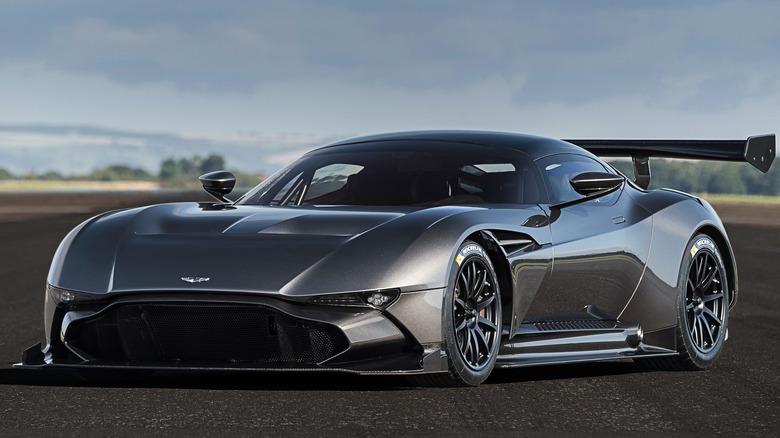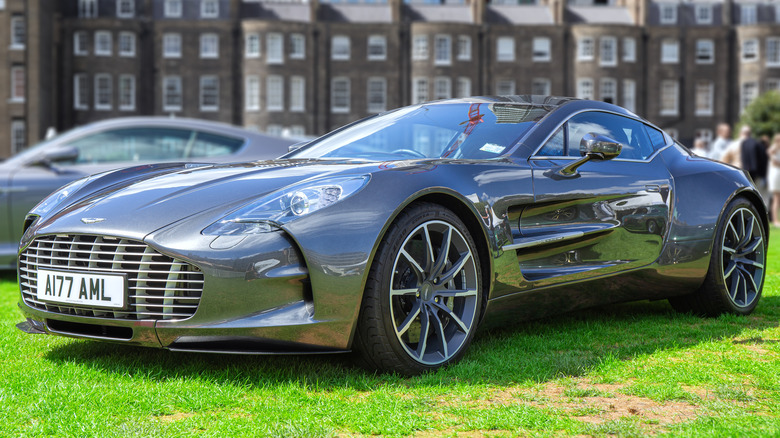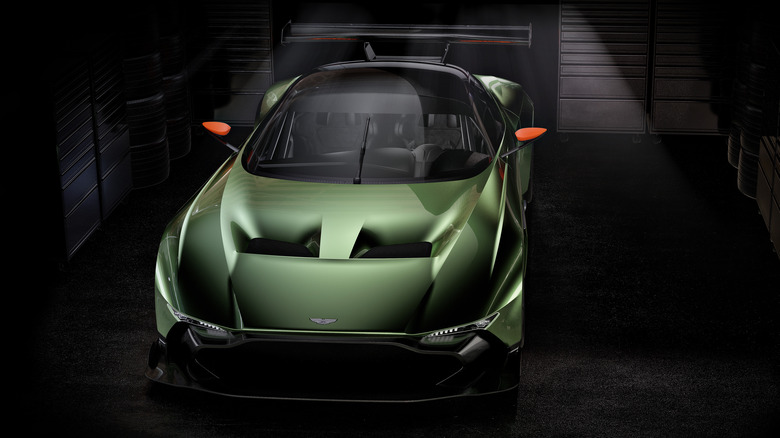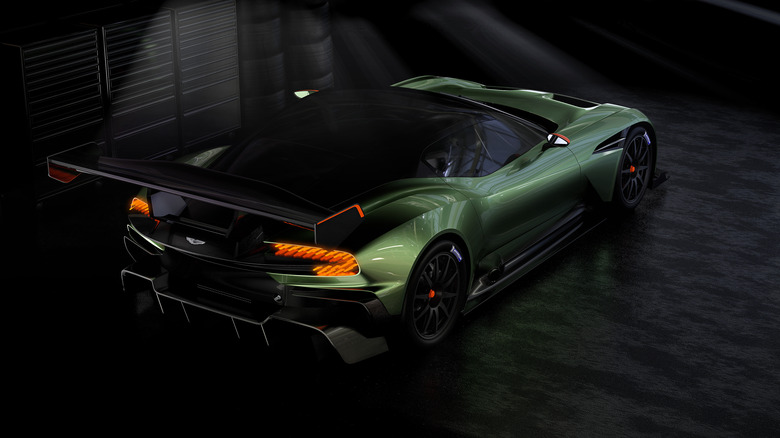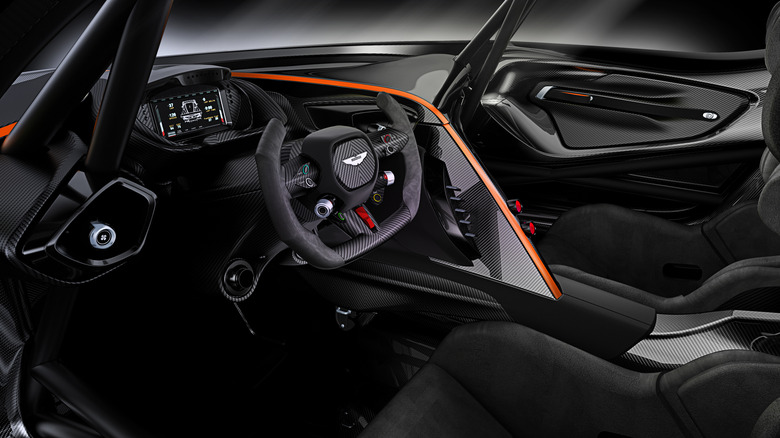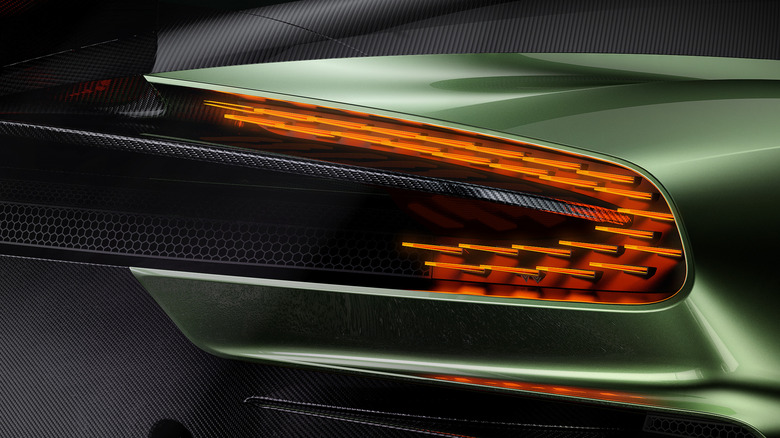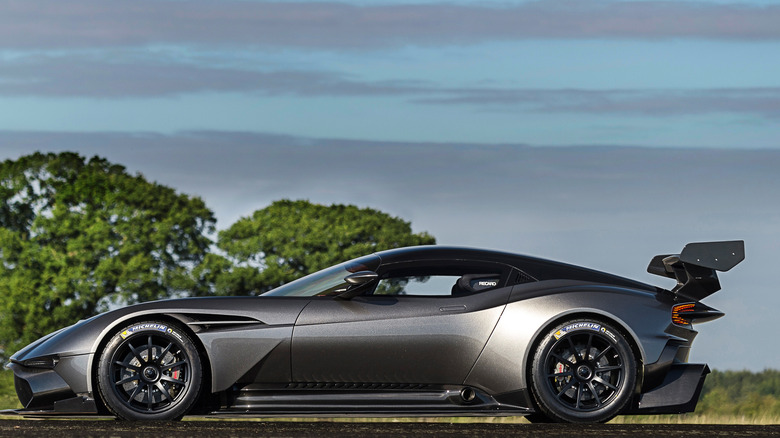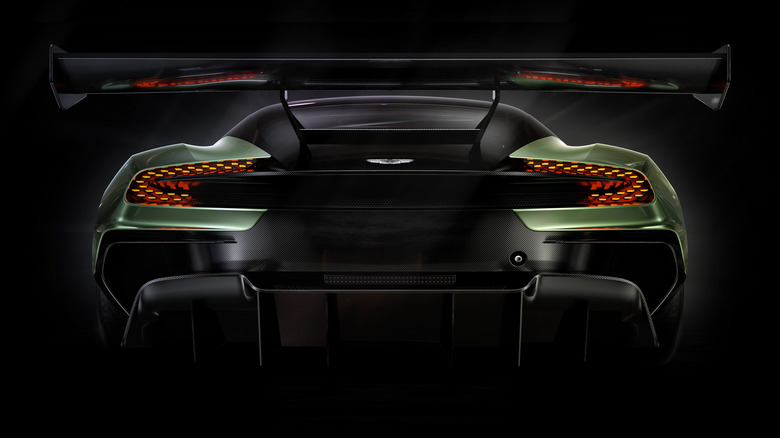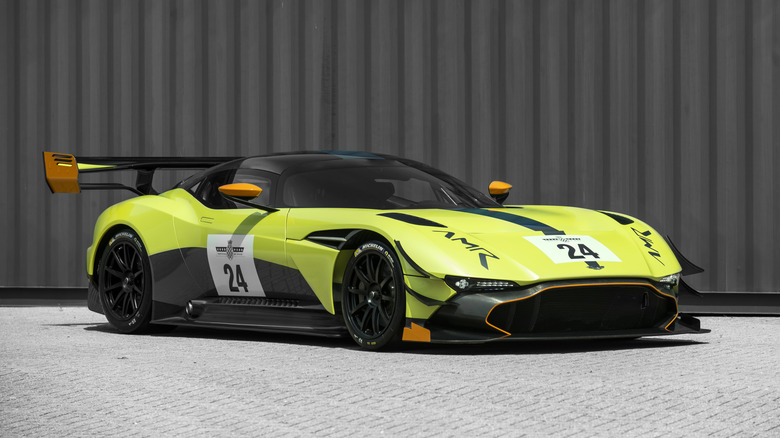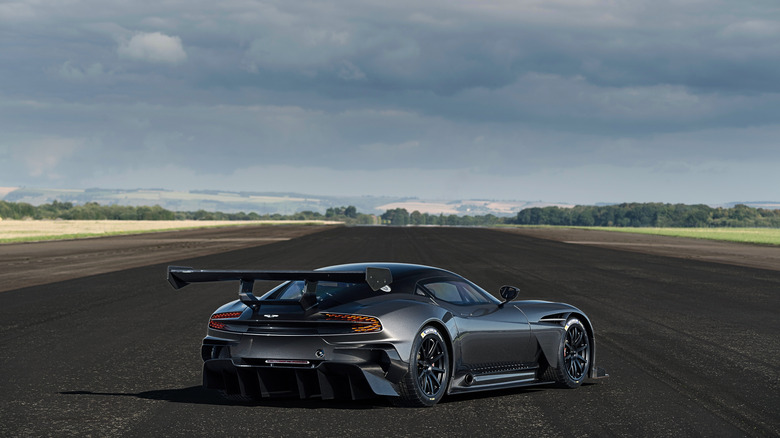The Best Features Of The Aston Martin Vulcan
Aston Martin has a long history of producing groundbreaking cars, from the stunning classic DBR1 to the cutting-edge One-77 supercar. The One-77 was limited to just 77 examples, hence its name. Since then, however, the British outfit has built a number of further special edition cars based on its platform. One of those specials is the Vulcan, a track-only hypercar that combines elements of Aston Martin's racing program with the bones of its most exclusive road car.
The task for the Vulcan was simply to let the company's design teams loose to create something that didn't have to conform to any particular set of regulations. Since it's not road legal, there are no emissions or design regulations to worry about, and since it's not made for any particular racing series, there were no limits set on its power output. The result is one of the most extreme track day toys of the past decade, with even Aston Martin's press release calling it the company's "wildest ever car."
Built on the underpinnings of the One-77
The Vulcan might be a milestone in Aston Martin's history of making track cars, but it was conceived partly by chance. The Vulcan's chassis, sub-frames, and suspension layout carried over from the One-77, and Top Gear reports that the only reason Aston Martin decided to make the Vulcan in the first place was because they had some spare One-77 development chassis lying around.
Originally, the plan was to make a faster version of the One-77, a sort of "One-77 R," but as development of the car progressed, it evolved into an entirely new beast. The design team proposed an entirely carbon fiber body shell instead of the original car's aluminum panels, and Aston Martin's racing division came up with the idea of replacing the One-77's stock V12 with a modified version of the V12 found in the Vantage GT3 race car. By that point, the car was something altogether different from the original One-77, and so the decision was made to christen the new car the "Vulcan." According to Aston Martin, the name was taken from a 1950s British bomber aircraft, which fittingly, made its last-ever flight within a few weeks of its hypercar namesake's debut.
7.0-liter racing V12 engine
While the car's V12 engine was taken from the Vantage GT3 racer, it underwent a number of changes before Aston Martin's engineers got the green light to put it in the Vulcan. The standard GT3 V12 featured a displacement of 6 liters, but an extra liter of displacement was added for the Vulcan engine (via Top Gear). This helped the team reach a total power output of 820 horsepower for the car, although drivers don't have to use all of that power on the track. Instead, there are three options that can be selected via a rotary controller on the dash: 550 horsepower, 675 horsepower, or the full amount.
With no noise regulations to adhere to, the Vulcan's engine emits one of the most visceral soundtracks of any Aston Martin to date. It's very much a theatrical experience as well as simply a lap-time crunching machine, both for the driver and for any onlookers lucky enough to see the car in action. However, anyone getting close to the Vulcan for a long period of time should bring suitable ear protection — at full throttle, the car emits 118dB of noise, according to Autocar. For reference, that's around the same as the average rock concert.
Over 3,000 pounds of downforce
While the Vulcan isn't specifically designed for any racing series, the chassis built by Aston Martin's partner Multimatic does feature an FIA-compliant steel roll cage and there's race-spec suspension to handle all the downforce the car generates at high speed. And there is a lot of downforce — 3,002 pounds of it, in fact, which is more than the weight of the car (via SuperVettura). With all its horsepower fed to the rear wheels only, the Vulcan employs a huge rear wing which generates a significant portion of that downforce, helping the car to stick to the asphalt through high-speed turns.
Also helping to make sure grip levels remain optimal are the Michelin Pilot Sport Cup 2 tires, and if the driver finds that the car is approaching the limits of its grip, a set of Brembo carbon ceramic race brakes should quickly help get things under control. All this adds up to create what Aston Martin calls "truly extreme performance," although not to the point that the car is ever too difficult to drive. The brand points out that owners can "precisely tailor their track day experience through a graduating scale of detailed power and dynamic performance adjustments." In other words, dial things down if the Vulcan's full power gets a bit much to handle.
Race-ready interior
Designing an earth-shatteringly quick performance car is one thing, but for buyers to cough up a seven-figure sum for one, it needs to look the part, both inside and out. It's safe to say that, with its wild aero kit and race-car styling, Aston Martin nailed the Vulcan's exterior. The interior didn't miss either, with figure-hugging carbon fiber Recaro seats ready to welcome the driver into a cockpit that looks straight out of a Le Mans racer. There's exposed carbon fiber everywhere, with a variety of buttons and switches jutting out of the steering wheel and central divider.
The steering wheel itself is Formula 1-inspired, and mounted in the middle, an ominous red switch simply reads "Start." A digital dash provides drivers with a customizable way to keep track of speed, revs, pressures, and suchlike, and there are no other gauges or readouts to provide a distraction while on track. The car isn't luxurious by any stretch of the imagination, but Top Gear notes that the fit and finish inside is exceptional, with everything from the paddle shifters to the leather door handle strap befitting of such an expensive vehicle.
Unique tail lights
One of the most unique features of the Vulcan is its rear tail lights, which take the form of a set of "blades" that light up individually to become one unit from a distance. There are a total of 27 LED blades that make up each light, and they're carefully arranged around the carbon fiber lip that sticks out of the rear of the car. It's a design that wouldn't be possible on a car that had to conform to road safety standards, and wouldn't be seen as necessary on anything built specifically for a racing series.
Perhaps that's one of the key things that sets the Vulcan apart from its peers: it's almost unnecessarily innovative. Aston Martin didn't have to create such a unique track day special, but they were given the freedom to do so, and decided to do it anyway. There are many other elements of the Vulcan that didn't have to be as extreme as they were, but when a car exists solely to satisfy the design whims of Aston Martin's most creative minds, then there's no reason not to push the envelope on every single aspect of that design. That even extends down to little details like the tail lights.
Starting price of around $2.4 million
Just as extreme as the Vulcan's design is its price, with the car selling for around $2.4 million when currency conversion and taxes are taken into account. That's only a base price too, as Aston Martin offered plenty of optional extras for owners who wanted to customize their car even further. Perhaps unsurprisingly for such a milestone car, the Vulcan has held its value very well in the years since its initial release, with build number 15 currently for sale at the time of writing for £2,500,000 (around $3.02 million). The car sports just 90 kilometers on the odometer, or around 56 miles.
Evidently, the owner of the car didn't spend much time (if any) in it since it was delivered in August 2016, and that seems like a shame. Although you could describe the Vulcan as a kind of automotive art piece, the point of its development was to be the ultimate track day weapon. It was designed to be driven, although it seems not every owner got the memo. Hopefully, its eventual new owner will do more than leave it sitting in a climate-controlled garage somewhere.
Limited to just 24 examples
Even if you're the kind of person that happens to have a spare $3 million lying around, it's very unlikely you'll be able to get your hands on a Vulcan once the currently listed example sells. Only 24 examples of the car were built, making them exceedingly rare even by hypercar standards. For comparison, the equally-mad Aston Martin Valkyrie, announced shortly after the Vulcan as the brand's first road-legal hypercar, will see 150 units produced in coupe form, and 85 units in spyder form.
Even the Ferrari FXX-K, the LaFerrari-based track toy that's one of the Vulcan's most direct rivals, saw at least 40 units produced (although it may have been more but no one knows because ... Ferrari). In short, anyone lucky enough to own a Vulcan can count themselves as part of a very exclusive club, even more exclusive than many of their hypercar-owning peers. And if there's one thing that billionaire collectors like, it's to own something that's just that little bit rarer than what everyone else has.
Upgraded AMR Pro
If, for some reason, any Vulcan owners took one look at their car and thought it wasn't fast enough, then Aston Martin also offered an AMR Pro upgrade that promised to make the car even more extreme. An enhanced aero kit was included to produce extra downforce, and a new, dual-plane rear wing was fitted which optimized the design of the original. The engine cover was also redesigned to reduce weight by an extra 5 kilos (11 pounds), and the changes helped improve the car's balance even further.
The company claims that by shifting the "center of pressure" closer to the middle of the car, the AMR Pro's traction, steering response, and front-end grip are all significantly improved over the standard Vulcan. This upgrade was made available to any Vulcan owners through Aston Martin's Advanced Operations division, although it's not been made public exactly how many owners chose to take their car in for the conversion. The cost of the AMR Pro conversion was also never publicly disclosed, but if you're wealthy enough to own a Vulcan in the first place, then let's face it, it's unlikely that you'd need to ask.
Road-legal conversion available
Although the Vulcan was specifically designed not to be road legal, one owner decided that they wanted to stick on some license plates and take it on the highway anyway. Except, it was far from that simple, as the conversion process required making some major changes to the car, and cost several hundred thousand dollars on top of the original purchase price (via Motor1). The street conversion was handled by RML Group but had full support from the Aston Martin factory, and after completion, it became the only road-legal Vulcan in existence.
Among the litany of changes required were the addition of windshield wipers, side mirrors, and a central locking system. Michelin road tires were also fitted, and a new set of headlights had to be installed to meet height requirements for British roads. The bladed tail lights were also covered over for safety, and a few of the sharper surface edges around the cabin were smoothed out. Then, the engine was remapped to meet emissions requirements, the suspension was softened, and a lift system was installed to give the car extra clearance for speed bumps. After all that, plus a few final touches, a license plate was fitted and the car was ready to go. Unfortunately, it seems like the owner's enthusiasm for taking it on the road quickly evaporated, as checking the car's plates against the British government database shows that its MOT (the annual national roadworthiness test) certificate expired back in January 2022.
